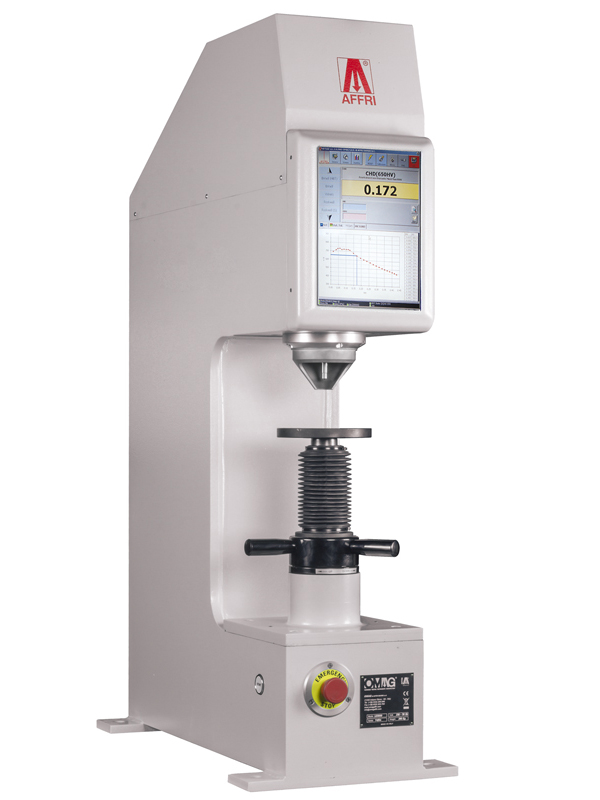LD 3000 AF: Vickers. Brinell. Rockwell
Venligst kontakt os for pris.
LD 3000 AF: Vickers. Brinell. Rockwell
LD 3000 AF. Automatic hardness tester for Rockwell, Brinell, Vickers and CHD test methods in compliance with ASTM and ISO hardness standards. The LD 3000 AF is built for measuring the thickness of the superficial hardness and will determine (CHD) Case Hardness Depth from 0.12 mm to 2 mm, with no need to destroy the specimen or to separate material types before performing the test. With just one measurement it reduces hardness testing time and costs compared to traditional polished cross section of Vickers and knoop methods.
Load forces are applied through load cells and electronically controlled in Closed Loop (Pat. Affri). This hardness tester is entirely motorized and it is equipped with a wide touchscreen for ease in test planning and a clear view of results. Statistics and CHD charts are automatically generated and can be stored with the test session in the large archive. User friendly interface with conversion tables and round correction values for tests on covex cylindrical surfaces or various diameters. For hardness case depth test with non-destructive method on all metals: Iron, steel, tempered steel, cast iron, brass, aluminum, copper and metal alloys. Heat treatment, hardening, nitriding, cementation and hardfacing.
Test loads: from 10 to 3000 kgf (From 29,4 to 29403 N)
CHD: 525 – 550 – 600 – 650 (More on request)
Vickers ISO 6507 / ASTM E-384 (Only indentation): HV3 – HV5 – HV10 – HV20 – HV30 – HV50 – HV100
Brinell HBWT ISO 6506 / ASTM E-10: HBWT2.5/62.5 – HBWT2.5/187.5 – HBWT5/125 – HBWT5/250 – HBWT5/750 – HBWT10/500 – HBWT10/1000 – HBWT10/1500 – HBWT10/3000 – HBW1/10 – HBW1/30 – HBW2.5/62.5 – HBW2.5/187.5 – HBW5/25 – HRW5/62,5 – HBW5/125 – HBW5/250 – HBW5/750 – HBW10/100 – HBW10/250 – HBW10/500 – HBW10/1000 – HBW10/1500 – HBW10/3000
Rockwell ISO 6508 / ASTM E-18: HRA – HRB – HRC – HRD – HRE – HRF – HRG – HRH – HRK – HRN – HRT
HDTL METHOD
Definition of the superficial hardness and its effective depth (CHD) from 0.12 a 2 mm. LD 3000 AF will determine the Case Hardness Depth (CHD) with great precision and minimal operator intervention, on finished products, without destroying the specimen and testing rather than random sampling of manufactured products. There’s no need for sample preparation, no need to separate material types or to polish the cross section as in the Vickers method. In just one minute the tester generates the report with the CHD graph.
CLOSED LOOP (PAT. AFFRI)
The force by load cell and the closed loop AFFRI system assures absolute accuracy on all test conditions. Closed Loop load cells manage load forces, which are automatically programmed and controlled at each test assuring perfect linearity in every range eliminating the problems associated with dead weight systems on traditional testers. Results are not affected by any structural deflection, misalignment or vibration. The system can also operate in an inclined position.
EASY AND FAST AUTOMATIC MEASUREMENTS:
Spin the leveling screw handle until the sample makes contact with the clamping hood blocking the piece. Press the START button and the measuring head will approach the specimen, apply the load to perform the indentation and goes back upward; all in automatic succession without breaching a phase. When testing unstable samples or deflective parts, the AFFRI System will follow the sample and not lose contact, compensating any frame deflection during the test cycle. Accurate results are assured even with oiled, dusty or dirty pieces.
TECHNICAL FEATURES LD 3000 AF
|
LD 3000 AF
|
|
|
Standards
|
EN-ISO 6508 / EN-ISO 14577 / ASTM E-18 / ASTM E-384
|
|
Indenter and clamping-hood stroke
|
30 mm
|
|
Elevating screw stroke
|
150 mm
|
|
Depth capacity
|
190 mm
|
|
Test loads
|
Vickers: 98.07 – 147.1 – 294.2 – 490.35 – 980.7 N (10 – 15 – 30 – 50 – 100 kgf)
Brinell: 98.07 – 153.2 – 294.2 – 306.5 – 612.9 – 1839 – 2450 – 4900 – 7350 – 9807 N (29403 N on request) Rockwell: 588.4 – 980.7 – 1471 N (60 – 100 – 150 kgf) Superficial Rockwell: 147.1 – 294.2 – 441.3 N (15 – 30 – 45 kgf) |
|
Feasible tests
|
HDTL con curva CHD: 525 – 550 – 600 – 650 (More on request)
Vickers: HV10 – HV15 – HV30 – HV50 – HV100
Brinell HBWT: HB30 – HB10 – HB5 – HB2.5 MPa (F/D2)
Rockwell: HRA – HRB – HRC – HRD – HRE – HRF – HRG – HRH – HRK
Superficial Rockwell: HRN – HRT
|
|
Load accuracy
|
Better than 0.05 %
|
VICKERS AND KNOOP HARDNESS TEST – ASTM E384 E92 – ISO 6507
- Scope:
Vickers and Knoop hardness tests have been found to be very useful for materials evaluation, quality control of manufacturing processes and research and development efforts. Hardness, although empirical in nature, can be correlated to tensile strength for many metals, and is an indicator of wear resistance and ductility. - Vickers and Knoop hardness test principle:An indentation hardness test using a verified machine to force an indenter, under specified conditions, into the surface of the material under test. The shape of the resulting indentation is measured after removal of the force. The general principle of the Vickers and Knoop indentation hardness test consists of two steps:
- The applicable specified indenter is brought into contact with the test specimen in a direction normal to the surface, and the test force F is applied. The test force is held for a specified dwell time and then removed.
- For the Vickers hardness test, the lengths of the two diagonals are measured and the mean diagonal length is calculated, which is used to derive the Vickers hardness value. For the Knoop hardness test, the length of the long diagonal is measured, which is used to derive the Knoop hardness value.
For micro indentation testing, the indenter shall contact the specimen at a velocity between 15 and 70 μm/s and should not exceed 0.2 mm/s. The time from the initial application of the force until the full test force is reached shall not be more than 10 s. The full test force shall be applied for 10 to 15 s unless otherwise specified.
- Representation of Vickers and Knoop hardness value: Vickers and Knoop hardness values are not designated by a number alone because it is necessary to indicate which force has been employed in making the test. The hardness numbers shall be followed by the symbol HV for Vickers hardness, or HK for Knoop hardness, and be supplemented by a value representing the test force in kgf. Examples: 450 HV 10 = Vickers hardness number of 450 obtained with a test force of 10 kgf, 700 HV 0.1 = Vickers hardness number of 700 obtained with a test force of 100 gf (0.1 kgf), 500 HK 0.5 = Knoop hardness number of 500 obtained with a test force of 500 gf (0.5 kgf).
- Microindentation hardness tests: Micro indentation hardness tests extend testing to materials that are too thin or too small for macro indentation hardness tests. Micro indentation hardness tests also allow specific phases or constituents and regions or gradients too small for macro indentation hardness testing to be evaluated. Recommendations for micro indentation testing can be found in Test Method ASTM E384.
- Sample surface preparation: For optimum accuracy of measurement, the test should be performed on a flat specimen with a polished or otherwise suitably prepared surface. The quality of the required surface finish can vary with the forces and magnifications used. The lower the test force and the smaller the indentation size, the more critical is the surface preparation. In all tests, the preparation should be such that the indentation perimeter and the indentation tips in particular, can be clearly defined when observed by the measuring system. The test surface shall be free of any defects that could affect the indentation or the subsequent measurement of the diagonals. The specimen surface should not be etched before making an indentation. Etched surfaces can obscure the edge of the indentation, making an accurate measurement of the size of the indentation difficult.
- Specimen preparation: To obtain usable information from the test, the specimen should be prepared or mounted so that the test surface is perpendicular to the axis of the indenter. Non-parallel test specimens can be tested using clamping and leveling fixtures designed to align the test surface properly to the indenter. In many instances, especially in micro indentation testing, it is necessary to mount the specimen for convenience in preparation and to maintain a sharp edge when surface gradient tests are to be performed on the test specimen. When mounting is required, the specimen shall be adequately supported by the mounting medium so that the specimen does not move during force application, that is, avoid the use of polymeric mounting compounds that creep under the indenter force.
- Measurement of Indentation: Measure both diagonals of a Vickers indentation or the long diagonal of a Knoop indentation. To stay within the flat field of the objective, the indentation length should not exceed 75% of the field width. The objective selected to measure the indentation should have an objective resolution (robj) that is ≤ 2% of the diagonal length to be measured.
- Determine the length of the diagonals to within 0.5 μm or less. For indentations less than 40 μm, determine the length of the diagonals to within 0.25 μm or less. For indentations less than 20 μm, the length of the diagonals should be determined to within 0.1 μm or less.
- A Vickers indentation, if one half of either diagonal is more than 5 % longer than the other half of that diagonal, or if the four corners of the indentation are not in sharp focus, the test surface may not be perpendicular to the indenter axis. For a Knoop indentation, if one half of the long diagonal is greater than 10 % longer than the other, or if both ends of the indentation are not in sharp focus, the test specimen surface may not be perpendicular to the indenter axis.
- Testing ambient temperature: Vickers and Knoop hardness tests should be carried out at a temperature within the limits of 10 to 35°C (50 to 95°F). Because variations within this temperature range may affect results, users may choose to control tempera- true within a tighter range.
PRINCIPLE OF THE VICKERS HARDNESS TEST LD 3000 AF:
The test consists of punching into the piece to be tested, using a determined force, a pyramid shaped indenter with a square base, having an angle of 136° to the summit and in measuring the diagonal (d) of the indent left in the piece, after having removed the load. The Vickers hardness is the quotient of the test load (F in kgf) for the area of the indent (in mm), considered to be an upside-down pyramid with a square base.

VICKERS APPLICATION SCALES:
The test forces in kgf define the Vickers hardness scales.
| Vickers scale | Knoop scale | Test force (N) | Test force (kgf) | Test force (g) |
| HV 0.001 | HK 0.001 | 0.009807 | 0.001 | 1 |
| HV 0.01 | HK 0.01 | 0.09807 | 0.01 | 10 |
| HV 0.015 | HK 0.015 | 0.1471 | 0.015 | 15 |
| HV 0.02 | HK 0.02 | 0.1961 | 0.02 | 20 |
| HV 0.025 | HK 0.025 | 0.2451 | 0.025 | 25 |
| HV 0.05 | HK 0.05 | 0.4903 | 0.05 | 50 |
| HV 0.1 | HK 0.1 | 0.9807 | 0.1 | 100 |
| HV 0.2 | HK 0.2 | 1.961 | 0.2 | 200 |
| HV 0.3 | HK 0.3 | 2.942 | 0.3 | 300 |
| HV 0.5 | HK 0.5 | 4.903 | 0.5 | 500 |
| HV 1 | HK 1 | 9.807 | 1 | 1000 |
| HV 2 | HK 2 | 19.61 | 2 | 2000 |
| HV 3 | 29.41 | 3 | ||
| HV 5 | 49.03 | 5 | ||
| HV 10 | 98.07 | 10 | ||
| HV 20 | 196.1 | 20 | ||
| HV 30 | 294.1 | 30 | ||
| HV 50 | 490.3 | 50 | ||
| HV 100 | 980.7 | 100 | ||
| HV 120 | 1177 | 120 |
MINIMUM RECOMMENDED SPACING FOR VICKERS AND KNOOP INDENTATIONS LD 3000 AF:
Generally more than one indentation is made on a test specimen. It is necessary to ensure that the spacing between indentations is large enough so that adjacent tests do not interfere with each other. For most testing purposes, the minimum recommended spacing between separate tests, and minimum distance between an indentation and the edge of the specimen is 2.5 times.

TERMINOLOGY AND TIPS:
- Calibration – determination of the values of the significant parameters by comparison with values indicated by a reference instrument or by a set of reference standards.
- Standardization – to bring in conformance to a known standard through verification or calibration.
- Verification – checking or testing to assure conformance with the specification. Vickers testing machines shall be verified periodically using test blocks.
- Vickers hardness machine – The testing machine shall support the test specimen and control the movement of the indenter into the specimen under a preselected test force, and should have a light optical microscope to select the desired test location and to measure the size of the indentation produced by the test. The plane of the surface of the test specimen should be perpendicular to the axis of the indenter which is the direction of the force application.
- The repeatability R – The repeatability R in the performance of a Vickers or Knoop hardness machine at each hardness level, under the particular verification conditions, is determined from n diagonal measurements made on a standardized test block as part of a performance verification. The repeatability is estimated as the percent range of n diagonal measurements with respect to the measured average hardness value.
- The error E – The error E in the performance of a Vickers or Knoop hardness machine at each hardness level, relative to a standardized reference value, is calculated as a percent error determined.
- Indenters – The ideal Vickers indenter is a highly polished, pointed, square-based pyramidal diamond with face angles of 136° 0’. The ideal Knoop indenter is a highly polished, pointed, rhombic-based, pyramidal diamond. The included longitudinal edge angles are 172° 30’ and 130° 0’. Indenters should be examined periodically and re- placed if they become worn, dulled, chipped, cracked or separated from the mounting material. Checks of the indenter by the user may be performed by visual inspection of the resulting indentations performed on test blocks.
- Specimen Support – A specimen support or “anvil” shall be used that is suitable for supporting the specimen to be tested. The seating and supporting surfaces of all anvils shall be clean and smooth and shall be free from pits, deep scratches, and foreign material. If the anvil is damaged from any cause, it shall be repaired or replaced. Common specimen support anvils should have a minimum hardness of 58 HRC.
Flat pieces should be tested on a flat anvil that has a smooth, flat bearing surface whose plane is perpendicular to the axis of the indenter.
Small diameter cylindrical pieces shall be tested with a hard V-grooved anvil with the axis of the V-groove directly under the indenter, or on hard, parallel, twin cylinders properly positioned and clamped in their base.
Special anvils or fixtures, including clamping fixtures, may be required for testing pieces or parts that cannot be supported by standard anvils.
Normal lagervare, forbehold for mellemsalg










